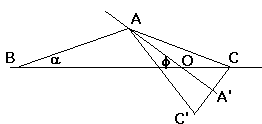Problem of Equal Steps II
The following problem was invented by Dan Shapiro from Ohio State University. I obtained it through the good services and enthusiasm of Professor William McWorter.
Let OL and OM be lines meeting at O making an angle f. Pick a point B on OL and another A on OM and, in steps of fixed length AB, step from one line to the other, never retracing a step. Suppose that, after n>2 steps, you return to B. What can be said about n and the angle f?
This same problem is discussed elsewhere. The difference is in the implementation of applets. Here, the angle f between the lines is defined as 180°·m/n, where m and n are determined via two spin controls. In the other page, the angle is defined directly from 0° to 179° in increments of 1°.
(The angle between the lines can be adjusted with the scroll bar. The small circles on the lines define the starting step (from one of the points to the other.) To clear the applet area before starting another set of iterations, click on the applet. In addition, the applet allows you to display steps and distances to the origin relative to a fixed point.)
| What if applet does not run? |
To see what's happening here consider this diagram:
 |
AO and BO are the two given lines forming angle f, as shown. The first step is made from B to A and the second from A to C. Denote angle ABO as a, and let's compute several other angles. Our goal is to determine the angle BAC', where C' is the reflection of C in line AO.
Since AB = AC, ΔBAC is isosceles, so that
| ∠ACB = a. |
∠AOC = p - f, and successively we can find that
| ∠OAC' = ∠OAC = p - (p - f) - a = f - a. |
| ∠OAB = p - f - a. |
And finally,
| ∠BAC' = ∠OAB - ∠OAC' = (p - f - a) - (f - a) = p - 2f, |
remarkably independent of a. To make sure that this is always the case, it is necessary to consider other configurations that differ in relative positions of A and B and the magnitude of f. The fact is that the result is always the same:
Now imagine that instead of paper or computer screen we draw on a magic sheet that can be folded indefinitely. Before performing the second step fold over the line AO. C will fall on top of C'. From C (or C' which is the same) we now seek a point on AO other than A, but equidistant to A from C'. Assuming it exists, denote is as D and consider its reflection D' in OC'.
The angle A'OC' between OC' and OA', where A' designates the "other" end of OA opposite A, is the same f. This is because it's the reflection of angle A'OC in OA. Thus we fall into exactly same situation as discussed for the second step. As before, we may conclude that angle AC'D' =
If, as stipulated in the problem, the process ends at the point B in n steps, the broken line will form either a regular or a star n-gon. In the former case, taking into account that the sum of angles of a convex (and certainly that for the regular) n-gon is
| p - 2f = p·(n - 2)/n, |
from which f = p/n. However, there are two essentially different cases. If the process begins at point O, then, indeed in n steps we get a phantom n-gon. However, for other starting points, because of the necessary symmetry of the process, the phantom polygon is traversed twice, so that the angle f should be calculated from
What do we get for star polygons?
(In the applet, the sides of the n-gon are referred to as "phantom lines". You can see there the steps of the process shown as the radius-vectors emanating from the same point, and similarly for the phantom construction. Finally, to give additional reassurance to the folding argument above, you can visually verify that all steps of the "real" and the phantom construction produce points on exactly the same distance from the origin O.)
|Activities| |Contact| |Front page| |Contents| |Geometry|
Copyright © 1996-2018 Alexander Bogomolny
73576788
